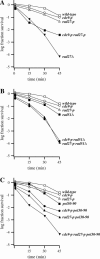Interactions among DNA ligase I, the flap endonuclease and proliferating cell nuclear antigen in the expansion and contraction of CAG repeat tracts in yeast
- PMID: 16079237
- PMCID: PMC1456850
- DOI: 10.1534/genetics.105.043448
Interactions among DNA ligase I, the flap endonuclease and proliferating cell nuclear antigen in the expansion and contraction of CAG repeat tracts in yeast
Abstract
Among replication mutations that destabilize CAG repeat tracts, mutations of RAD27, encoding the flap endonuclease, and CDC9, encoding DNA ligase I, increase the incidence of repeat tract expansions to the greatest extent. Both enzymes bind to proliferating cell nuclear antigen (PCNA). To understand whether weakening their interactions leads to CAG repeat tract expansions, we have employed alleles named rad27-p and cdc9-p that have orthologous alterations in their respective PCNA interaction peptide (PIP) box. Also, we employed the PCNA allele pol30-90, which has changes within its hydrophobic pocket that interact with the PIP box. All three alleles destabilize a long CAG repeat tract and yield more tract contractions than expansions. Combining rad27-p with cdc9-p increases the expansion frequency above the sum of the numbers recorded in the individual mutants. A similar additive increase in tract expansions occurs in the rad27-p pol30-90 double mutant but not in the cdc9-p pol30-90 double mutant. The frequency of contractions rises in all three double mutants to nearly the same extent. These results suggest that PCNA mediates the entry of the flap endonuclease and DNA ligase I into the process of Okazaki fragment joining, and this ordered entry is necessary to prevent CAG repeat tract expansions.
Figures



Similar articles
-
C-terminal flap endonuclease (rad27) mutations: lethal interactions with a DNA ligase I mutation (cdc9-p) and suppression by proliferating cell nuclear antigen (POL30) in Saccharomyces cerevisiae.Genetics. 2009 Sep;183(1):63-78. doi: 10.1534/genetics.109.103937. Epub 2009 Jul 13. Genetics. 2009. PMID: 19596905 Free PMC article.
-
Proliferating cell nuclear antigen prevents trinucleotide repeat expansions by promoting repeat deletion and hairpin removal.DNA Repair (Amst). 2016 Dec;48:17-29. doi: 10.1016/j.dnarep.2016.10.006. Epub 2016 Oct 22. DNA Repair (Amst). 2016. PMID: 27793507 Free PMC article.
-
The impact of lagging strand replication mutations on the stability of CAG repeat tracts in yeast.Genetics. 2000 Aug;155(4):1657-65. doi: 10.1093/genetics/155.4.1657. Genetics. 2000. PMID: 10924464 Free PMC article.
-
DNA base excision repair: a mechanism of trinucleotide repeat expansion.Trends Biochem Sci. 2012 Apr;37(4):162-72. doi: 10.1016/j.tibs.2011.12.002. Epub 2012 Jan 27. Trends Biochem Sci. 2012. PMID: 22285516 Free PMC article. Review.
-
Mechanisms of trinucleotide repeat instability during human development.Nat Rev Genet. 2010 Nov;11(11):786-99. doi: 10.1038/nrg2828. Nat Rev Genet. 2010. PMID: 20953213 Free PMC article. Review.
Cited by
-
On the wrong DNA track: Molecular mechanisms of repeat-mediated genome instability.J Biol Chem. 2020 Mar 27;295(13):4134-4170. doi: 10.1074/jbc.REV119.007678. Epub 2020 Feb 14. J Biol Chem. 2020. PMID: 32060097 Free PMC article. Review.
-
Determinants of Genetic Diversity of Spontaneous Drug Resistance in Bacteria.Genetics. 2016 Jul;203(3):1369-80. doi: 10.1534/genetics.115.185355. Epub 2016 May 10. Genetics. 2016. PMID: 27182949 Free PMC article.
-
A mutant allele of the transcription factor IIH helicase gene, RAD3, promotes loss of heterozygosity in response to a DNA replication defect in Saccharomyces cerevisiae.Genetics. 2007 Jul;176(3):1391-402. doi: 10.1534/genetics.107.073056. Epub 2007 May 4. Genetics. 2007. PMID: 17483411 Free PMC article.
-
Suppression of a DNA polymerase delta mutation by the absence of the high mobility group protein Hmo1 in Saccharomyces cerevisiae.Curr Genet. 2009 Apr;55(2):127-38. doi: 10.1007/s00294-009-0229-y. Epub 2009 Jan 31. Curr Genet. 2009. PMID: 19184026
-
DNA polymerase δ subunit Pol32 binds histone H3-H4 and couples nucleosome assembly with Okazaki fragment processing.Sci Adv. 2024 Aug 9;10(32):eado1739. doi: 10.1126/sciadv.ado1739. Epub 2024 Aug 9. Sci Adv. 2024. PMID: 39121223 Free PMC article.
References
-
- Bae, S.-H., E. Choi, K.-H. Lee, J. S. Park, S.-H. Lee et al., 1998. Dna2 of Saccharomyces cerevisiae possess a single-stranded DNA-specific endonuclease activity that is able to act on double-stranded DNA in the presence of ATP. J. Biol. Chem. 273: 26880–26890. - PubMed
-
- Bambara, R. A., R. S. Murante and L. A. Henricksen, 1997. Enzymes and reactions at the eukaryotic replication fork. J. Biol. Chem. 272: 4647–4650. - PubMed
-
- Bielinsky, A. K., and S. A. Gerbi, 1999. Chromosomal ARS1 has a single leading strand start site. Mol. Cell 3: 477–486. - PubMed
Publication types
MeSH terms
Substances
LinkOut - more resources
Full Text Sources
Molecular Biology Databases
Research Materials
Miscellaneous

